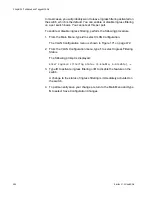
Chapter 24: Port-based and Tagged VLANs
490
Section VI: Virtual LANs
Deleting All VLANs
The following procedure deletes all port-based, tagged, protected ports,
and MAC address-based VLANs on a switch. To delete selected VLANs,
perform the procedure in “Deleting a Port-based or Tagged VLAN” on
page 487.
Note the following before performing this procedure:
You cannot delete the Default_VLAN.
You cannot delete a VLAN if it has a routing interface. The interface
must be deleted first. For instructions, refer to “Deleting a Routing
Interface” on page 554.
All ports on the switch are returned to the Default_VLAN as untagged
ports.
Static addresses assigned to the ports of the deleted VLANs become
obsolete and should be deleted from the MAC address table. For
instructions, refer to “Deleting Unicast and Multicast MAC Addresses”
on page 112.
To return all ports to the default VLAN, perform the following procedure:
1. From the Main Menu, type
2
to select VLAN Configuration.
The VLAN Configuration menu is shown in Figure 171 on page 472.
2. From the VLAN Configuration menu, type
3
to select Configure VLANs.
The Configure VLANs menu is shown in Figure 172 on page 473.
3. From the Configure VLANs menu, type
4
to select Reset to Default
VLAN.
The following prompt is displayed:
This operation deletes ALL user created VLANs!
Do you want to continue [Yes/No] ->
4. Type
Y
to delete all VLANs or
N
to cancel the procedure. Press
Return.
If you select Yes, all VLANs are deleted and the following message is
displayed:
SUCCESS
Please make sure to manually update any static
multicast MAC address(es) entries.
Press any key to continue...
All tagged and untagged ports are returned to the Default_VLAN as
untagged ports.
Summary of Contents for AT-9400
Page 16: ...Figures 16 ...
Page 18: ...Tables 18 ...
Page 28: ...Preface 28 ...
Page 30: ...30 Section I Basic Operations ...
Page 60: ...Chapter 1 Basic Switch Parameters 60 Section I Basic Operations ...
Page 64: ...Chapter 2 Port Parameters 64 Section I Basic Operations Port Type The port type ...
Page 84: ...Chapter 2 Port Parameters 84 Section I Basic Operations ...
Page 124: ...Chapter 6 Static Port Trunks 124 Section I Basic Operations ...
Page 144: ...144 Section II Advanced Operations ...
Page 196: ...Chapter 10 File Downloads and Uploads 196 Section II Advanced Operations ...
Page 218: ...Chapter 11 Event Logs and the Syslog Client 218 Section II Advanced Operations ...
Page 242: ...Chapter 13 Access Control Lists 242 Section II Advanced Operations ...
Page 294: ...294 Section III IGMP Snooping MLD Snooping and RRP Snooping ...
Page 314: ...Chapter 19 MLD Snooping 314 Section III IGMP Snooping MLD Snooping and RRP Snooping ...
Page 318: ...318 Section IV SNMPv3 ...
Page 416: ...Chapter 21 SNMPv3 416 Section IV SNMPv3 ...
Page 418: ...418 Section V Spanning Tree Protocols ...
Page 470: ...470 Section VI Virtual LANs ...
Page 520: ...Chapter 26 Multiple VLAN Modes 520 Section VI Virtual LANs ...
Page 532: ...Chapter 27 Protected Ports VLANs 532 Section VI Virtual LANs ...
Page 546: ...546 Section VII Internet Protocol Routing ...
Page 560: ...560 Section VIII Port Security ...
Page 568: ...Chapter 30 MAC Address based Port Security 568 Section VIII Port Security ...
Page 586: ...Chapter 31 802 1x Port based Network Access Control 586 Section VIII Port Security ...
Page 588: ...588 Section IX Management Security ...
Page 610: ...Chapter 33 Encryption Keys 610 Section IX Management Security ...
Page 650: ...Chapter 36 TACACS and RADIUS Protocols 650 Section IX Management Security ...
Page 660: ...Chapter 37 Management Access Control List 660 Section IX Management Security ...
Page 668: ...Index 668 ...






























